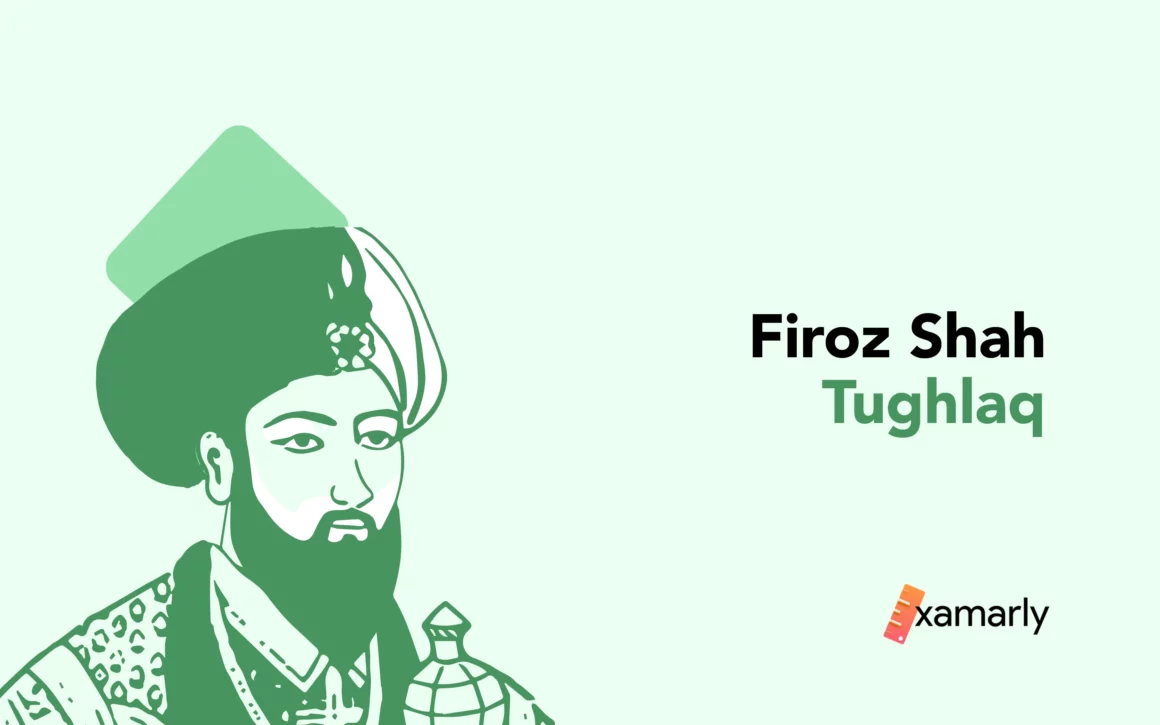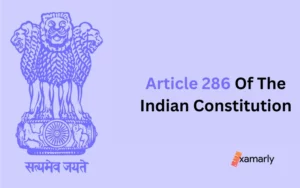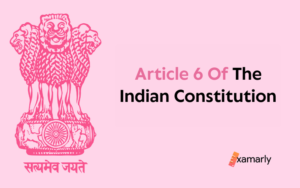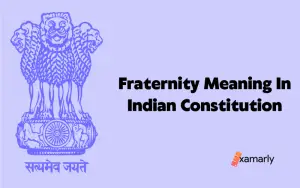As you turn the pages of the history of the Delhi Sultanate, you will often come across one of the renowned rulers, named Firoz Shah Tughlaq. He was a Muslim ruler of Turkic descent. He governed the Sultanate of Delhi from 1351 to 1388.
He received training in all areas of government and administration, including state policy, account-keeping, and appointment procedures. He served as the amir-i-hajib.
Let’s learn more about the decades of his reign through this article. In addition to his political and religious policies, Firoz Shah Tughlaq was majorly famous for his contribution to the development of infrastructure in his kingdom.
Let’s explore his achievements and find out about the Tughlaqs’ religious as well as administrative policies.
This article is worth reading for the aspirants preparing for UPSC Exam. This is covered in the section of Medieval Indian History of UPSC Syllabus.
Who was Firoz Shah Tughlaq?
Firoz Shah Tughlaq was the son of Rajab. Sipahsalar was the designation Rajab possessed. Ghazi Malik was his elder brother.
Sultan Feroz Shah was a ruler of the Tughlaq dynasty. He ruled over the Delhi Sultanate from 1351 to 1388.
The Tughlaq dynasty was a Turko-Indian family which ruled over India during the Sultanate period.
The Tughlaqs were famous for their cruelty, torture, and rebellions. They ruled over different parts of India, including Delhi and Bengal. Their reigns marked a change in the region and the culture of India.
Firoz was known for the destruction he caused to Puri’s Jagannath Temple.
Firoz was the successor of his cousin, Muhammad bin Tughlaq. Muhammad lost his life in Sindh while laying the ground against Taghi, a Turkic slave tribe.
Following this, no one came up to hold the reign of power. So the camp followers persuaded Firoz to take charge of the Delhi Sultanate. But as a result of the distress, his reign was more limited than Muhammad’s.
Reign
Sultan Feroz Shah Tughlaq was the third ruler of the Tughlaq dynasty. He ascended the throne after Muhammad-bin Tughlaq and had predecessors Ghiyasuddin Tughlaq before him. Firoz Shah allowed the people of these cities to have autonomy when he was in charge, even though he was a Muslim.
Firoz was heavily reliant on Malik Maqbul, his commander. He converted to Islam after being detained. He was referred to as the genuine king or “Khan-i-Jahan” by the Sultan. When Firoz Shah embarked on an expedition, Malik served as the monarch.
To stop other territories from becoming autonomous, he decided not to recapture provinces that had declared their independence.
A well-known builder, Firoz took an interest in construction projects in his region, and he also took part in the building of mosques and hospitals. He also began extensive irrigation projects, excavated five canals, and built fifty dams. He also built several mosques and palaces and translated Sanskrit books.
Firoz Shah Tughlaq’s religious policy centered around the concept of Sharia.
He abolished the Sondhar loan, which had been given by the state to the poor. In addition, Firoz waived the two-crore maal loan for peasants and created pilot farms to experiment with new agricultural technologies. He also instituted the Double System of Canals to supply irrigation to his people.
While Firoz was a beloved monarch, he had some shortcomings. His treasury bore a heavy burden. His lavish gifts helped avert the Mongol invasion. He also rebuilt the Qutub Minar, which had been destroyed by a disastrous earthquake.
Feroz designated an office for the deprived people, and this office was known as Diwan-i-Khairat. A separate area for the slaves, called Diwan-i-Bundagan (department of slaves), was constructed.
However, he made several mistakes during his reign, and his failure to build a tomb in the city weakened the Tughlaq dynasty. His death, however, pushed the city into an economic crisis.
Learners can learn more about Qutub Minar and other Delhi Sultanate Monuments through the linked article.
Challenges in the Reign
The Tughlaq dynasty of Mughal India had several internal and external challenges to overcome. It was due to the failure of Mohammad Bin Tughlaq’s grand project experiment. Firoz inherited an empire that was in a state of disarray.
Not being an effective military commander or administrator, he tried to resolve these problems through policies that were more akin to those of a peasant. Several territories proclaimed independence under his rule.
The 3 military campaigns organized by him ended in collapse. Hence, Feroz felt that he was incapable and he never tried to seize the lands that announced independence.
Firoz faced many challenges during his reign, including the rise of the Muslim Bahmani kingdom and the formation of independent states in Gujarat and Sindh. As a result, his reign remained relatively small compared to his predecessor, Muhammad bin Tughlaq. But Firuz was able to consolidate his state, bringing unprecedented prosperity to the central areas of his empire.
Religious Policies
The religious policies of Firoz Shah Tughlak were crucial to the success of the Tughlaq dynasty, which ruled Delhi from 1351 to 1388.
- Feroz Shah was a follower of orthodox religious policy. He considered the Ulemas in a dedicated position and made most of the decisions with their consultation.
- With the help of coercion and temptation, Islam was promoted. The conversion of religion was promoted by appointed understates.
- The Sultan of Delhi who inflicted Jazia over Brahmins was Feroz. Once a Brahmin mentioned that the elements of truth were a part of both Hinduism and Islam. Thus, on Sultan’s instructions, a Brahmin was set on fire.
- Feroz followed Shariyat and destroyed Hindu temples in his period of rule.
- Since Feroz was a son of a Hindu lady, hence his religion was questioned several times. And to prove his Islamic dedication, he used the orthodox method.
- Firoz Shah Tughlaq didn’t have the abilities needed to command and govern a military force successfully. Ulemas, Muslim Nobel, and other religious authorities had to lend a hand to him. He implemented a religious policy as a result.
Also read: Iqta System In Delhi Sultanate
Administration Reforms
In the reign of Feroz Shah Tughlaq, various reforms were initiated under his command. He realized various reforms that were necessary for the overall development and growth of the state. Some of his major reforms are-
- Revenue Reforms- With the thought of the goodwill of the people, Firoz omitted 21 miscellaneous assets. It reduced the burden of tax paying. The taxes were:
- Ushra – The land tax (Paid by the Muslims)
- Khums- The share of State of war booty
- Jizya- The religious tax (Paid by the Hindus)
- Jakat was paid as a religious tribute by Muslims.
- Judicial Reforms- When Feroz took over the regime, the judicial system was brutal and rude. The stories of accused men being executed in fire and water ordeals, death penalties, and severing of limbs were common. As Feroz ascended to the throne, he demolished the torture and abuse. He also lightened the penal code in the favour of normal people.
- Agrarian Reforms- During Muhammad’s reign, the state granted the Sondhar loan which was waived by Firoz. Approximately two crore currency was noted off. Canals were constructed for irrigation purposes, while superior crops were promoted. An irrigation fee called Haqq-i-Sharab was imposed on peasants who used the water from such canals. This tax was imposed at a 10% of output rate. Fresh agricultural technology and new seed development were tested on pilot farms, which are small-scale expansion farms.
- Canal System- In 1355, Firuz built a Double System of Canals. It stretched from the Yamuna to the Sutlej. This supported the just-founded city of Hissar-i-Firoza.
To learn about the Delhi Sultanate Administration, check out the linked article.
Taxes Imposed under Firoz Tughlaq
- The Tughlaq dynasty was ruled by Sultan Firoz Tughlaq. In this period, he abolished the 21 miscellaneous asses and abwabs that were in place.
- He also abolished five religious taxes, which were called Jizya and Jakat. Jizya was a poll tax levied on non-Muslims in Muslim lands.
- The Tughlaq dynasty imposed taxes. The lands were invaded, and land revenue was collected from them.
- The rate of land revenue rose as income increased, while the Zakat tax was levied on wealthy Muslims.
- Two-thirds of the money was given to the poor and the rest to the rich. The rulers of the time imposed taxes by taxing their subjects.
- Tughlaq abolished several unjust taxes, including the Sondhar loan, and collected four Islamic taxes. He also imposed Jizya (a tax on non-Muslims) on Brahmans.
- He collected irrigation taxes as well. The common people who utilized the canal water were supposed to pay for it.
- He also encouraged the conversion of Hindus to Islam. He destroyed Hindu temples and idols and raised mosques in their place. He encouraged Islamic law and religious education, and also made women go to their graves.
Constructions
- The construction and infrastructure implemented by Feroz were a plus point to his reign. He ordered the construction of schools, hospitals, river canals, rest houses, etc.
- He initiated new towns like Firozabad, Jaunpur, Fatehpur as well as Hissar.
- Darul-Shifa, Bimaristan or Shifa Khana, was the hospital for the people of the state’s benefit.
- A fort named Feroz Shah Kotla Fort was also established by Feroz in Delhi, in the 14th century.
- Several waterways systems were constructed on his orders, for example- the Yamuna to the city of Hissar, the Sutlej to the Ghaggar, the Ghaggar to Firuzabad, and Mandvi and Sirmour Hills to Hansi in Haryana.
- Under his reign, Tughlaq devoted himself to improving the infrastructure of his empire. The Qutub Minar, for example, was extended to five stories, and Firuz Tughlaq built many irrigation canals to aid farmers in farming.
- His irrigation system is credited for bringing about widespread agricultural development in India, and he also financed many of his projects.
Achievements
During his rule, Firoz Shah Tughlaq tried to suppress revolts and did his part for the welfare of the empire. His efforts were met with mixed reviews. The followings are some of his major accomplishments and the most important aspects of his reign-
- Feroz is more famous for commissioning buildings of architectural shapes that were seen as unconventional during his era. He is also considered the father of the irrigation system in India. He channelized rivers to provide water through canals to a large part of the country.
- He provided various irrigation facilities by building canals between Sutlej and Ghaggar rivers, Yamuna and Hissar city, and so on. He established a separate department for slaves and constructed Sarais which is a rest house for merchants and traders.
- Among other things, he introduced the principle of inheritance for soldiers. He also decreed that only the sons of nobles could succeed in a position. This restriction hindered the appointment of competent people to responsible posts.
- Another achievement of Tughlaq was that he rebuilt the Qutub Minar, a monument to his late father. Tughlaq enshrined the Qutub Minar as an architectural monument. He established the Diwan-i-Khairat and Diwan-i-Bundagan.
- Firoz Shah Tughlaq’s religious policy was extremely orthodox. He abolished several unjust taxes and introduced four Islamic taxes. He also banned torture and imposed a religious tax on Brahmans. His religious policy also included outlawing Hindu temples. He also banned the worship of idols and destroyed many Hindu temples, in addition to banning the practice of idolatry.
Also read: Diwan I Risalat: Ministry Of Foreign Affairs
The End of the Reign
The End of the Reign of Firoz Shah Toughlaq is an interesting period in Indian history. He died in 1388. After the demise of Firoz’s eldest son, he appointed the other son, Prince Muhammad, as the Sultan. Several slave rebels forced the Sultan to entitle his grandson to the king.
Following Tughlaq’s passing, the nobility rebelled to find their own nations, which led to a succession war. The next Sultan, Ghiyath Ud Din Tughluq Shah II, couldn’t handle the falling empire as the armed forces became incompetent. After ten years of Firuz’s death, Timur seized the city of Delhi and destroyed it.
He was the last ruler of the Tughlq Dynasty. Firoz Shah Tughlaq’s death marked the end of his dynasty, which disintegrated at the hands of Timur in 1398. While Firoz Shah Tughlaq was not an efficient administrator or military commander, his rule still left the country in a difficult situation.
The ruler’s sweeping reforms delayed the decline of the empire but didn’t end it. Firoz Shah Tughlaq is often remembered as one of the greatest rulers of the Indian subcontinent, and his autobiography is a fascinating read.
The Tomb
The magnificent tomb of Firoz Shah Tughlaq is located in Hauz Khas, Delhi. It is placed next to the tank constructed by Alauddin Khilji. A madrasa built by Firoz Shah is also close to it.
Although the tomb is the most prominent attraction in the complex, other sites in the complex include pavilions and Islamic seminaries. This complex has a medieval history dating back to the thirteenth century.
There are four graves in the tomb of Firoz Shah Tughlaq. Three of these are marble, while the fourth is plaster. The tomb also contains a fourth, unidentified grave near the east entrance.
The main grave is the one with inscriptions and has been identified as Firoz Shah’s. Two of these graves were built for his sons and grandson.
The interior of this tomb is beautifully carved and decorated. Its walls are made of gray stone slabs. Its ceiling and intrados are decorated with colored bands and chiseled scripts.
The intricately carved designs on the tomb include floral patterns and Quranic lines. The tomb is a perfect place to reflect a vision of paradise.
Conclusion
In his autobiography, Firoz Shah Tughlaq is described as the “Akbar” of the Sultanate. An empire that was facing significant difficulties was taken over by Firoz.
During his rule, Firoz Shah is well renowned for commissioning structures. Those structures had distinctive architectural shapes. He is also credited with founding India’s irrigation system, which used canals to divert rivers so they could supply water to most of the nation.
During his reign, he put into effect policies like tax changes, irrigation projects, philanthropic programs, and construction projects.
In the interest of additional readings:
| Delhi Sultanate Questions and Answers | Art and Architecture of Delhi Sultanate |
| Khilji Dynasty | Sayyid Dynasty Of Delhi Sultanate |
FAQs
What was Firoz Shah Tughlaq famous for?
During his rule, Firoz Shah is well renowned for commissioning structures with distinctive architectural shapes. He is also credited with founding India’s irrigation system, which used canals to divert rivers so they could supply water to most of the nation.
What reforms was Firoz Shah Tughlaq responsible for?
Firoz Tughlaq oversaw the implementation of initiatives like tax reforms, irrigation projects, humanitarian programs, and public works projects during his roughly 37-year rule, which spanned the years 1351 to 1388 A.D.
Who is the 1st Sultan to impose an irrigation tax?
It was Firoz Tughlaq who first levied an irrigation tax.
Who introduced the Sharb tax?
The sharab, also spelled sharb, was a tax on farmers equal to one-tenth of their crop yield that was used to construct and maintain water delivery facilities. Firuz Tughlaq was the one who initially proposed this.
Which Indian ruler introduced canal irrigation?
Firoz Shah Tughlaq is recognized as the first emperor to irrigate canals in India. His zeal for shoring up the empire’s underlying structures led him to construct its most extensive network of canals and other infrastructure. For channeling rivers to produce water through canals, he is regarded as the father of India’s irrigation system. He constructed five significant canals, including the renovation of the Western Yamuna canal from the Prithviraj Chauhan dynasty, for irrigation projects to cultivate the land for the production of grains and fruits.






